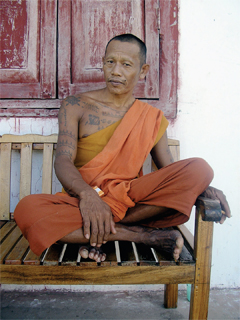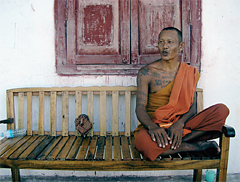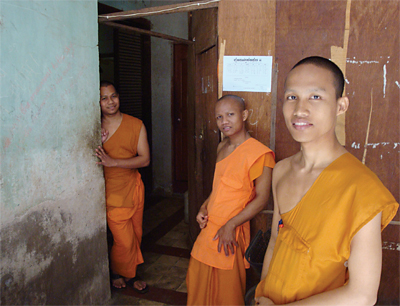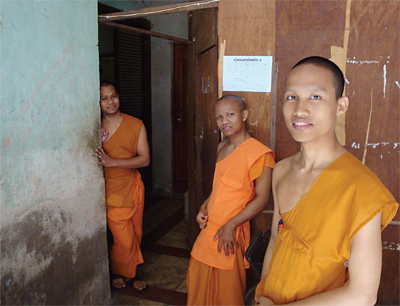
In early 2005, a young Cambodian monk named Rann Reuy was curious about the Khmer Rouge. He never learned about them in school—state censorship kept them out of the textbooks—but he’d done some of his own reading. He knew that the Khmer Rouge were a band of Communist purists who took control of Cambodia in April 1975 and promptly evacuated the cities, forcing the population to try out some of Mao’s worst agricultural ideas in rice paddies that would become known as the killing fields. He knew that after three and a half years of their rule, as many as two million Cambodians were dead, by starvation or execution. He knew that Pol Pot, who died in 1998, had been Brother Number One, and Nuon Chea, the party’s chief ideologue and supervisor of its brutal security system, had been Brother Number Two. He wanted to learn more. So he went to Pailin, a remote municipality along the Thai border, where old Khmer Rouge were known to retire in peace.
“When I reached Pailin,” Rann Reuy, now a journalist, said recently, “one of the monks said that Nuon Chea and his wife came to the pagoda on every holy day. I was so interested I asked him, ‘Could you one day guide me to meet him?’ He said, ‘Why not?’”
One morning in March, Rann Reuy approached Nuon Chea’s humble home, an elevated wooden shack with a corrugated tin roof. Nuon Chea welcomed Rann Reuy with a respectful bow. Ly Kimseng, Nuon Chea’s wife, made Rann Reuy a cup of hot Milo, and the monk and the Maoist settled into conversation. Nuon Chea was eager to talk religion.
“No other religion can compare to Buddhism,” Nuon Chea said, as Rann Reuy recalls it. “Buddhism teaches us right understanding, right living, right action, right concentration, right meditation. If all governments would follow Buddhism, no countries would ever have conflict.”
Rann Reuy was astonished. After all, as soon as the Khmer Rouge took power, they had executed as many of Cambodia’s senior and learned monks as they could and forcibly defrocked the rest. Most religious traditions were blotted out. The French priest and writer François Ponchaud recorded a 1975 Khmer Rouge directive: “If any worker secretly takes rice to the [monks], we shall set him to planting cabbages. If the cabbages are not full grown in three days, he will dig his own grave.” Two-thirds of Cambodia’s temples were destroyed; others were turned into pigsties or prisons. By the time the Khmer Rouge fell in early 1979, only a handful of monks remained.
In his youth, Nuon Chea told Rann Reuy, he was himself briefly a monk. He said he still observed the five Buddhist precepts, the first of which is a promise not to kill. Why, then, Rann Reuy asked him, was there so much killing during the time of his rule?
Nuon Chea did not hesitate to reply. “The killing was just disputes between the local people and local authorities,” he said. “The top people didn’t know. I didn’t know about that—I didn’t know at all.”
Rann Reuy could tell that Nuon Chea was annoyed by this line of questioning, but he persisted. If Buddhism is so admirable, he asked, why had the Khmer Rouge outlawed the monkhood?
Nuon Chea again answered quickly. “At that time the government policy was that all people had to farm, so the monks had to farm too,” he said. “All people were required to farm together to produce more products in Cambodia.”
Rann Reuy wasn’t sure how to respond. “I just listened; I didn’t have any bad feeling or angry feeling toward him,” he told me. “As a Buddhist monk, I just have to listen and remember in my mind.”
Today Nuon Chea is locked in a cell on the outskirts of Phnom Penh, awaiting a trial for war crimes. If he’s found not guilty, he has said, he may become a monk again.
Buddhism has existed in Cambodia for more than 1,500 years. Theravada Buddhism, a traditionalist school that is also widely practiced in Sri Lanka, Thailand, and Burma, has predominated for the last 600. Before the Khmer Rouge era, 95 percent of Cambodians identified themselves as Buddhist. Despite the recent influx of foreign missionaries—many of them from the United States, but many also from Asian countries such as South Korea and Japan—95 percent say the same today.
Sandwiched between two assertive neighbors, Thailand and Vietnam, Cambodia has endured a seemingly endless succession of wars and occupations over the centuries, but Buddhism has endured. In the 19th century, Cambodia became a French protectorate; in the 20th, monks helped bring French rule to an end. On July 20, 1942, in an event that became known as the Umbrella War, around 500 monks led a mass march that was “the first coordinated act of the anti-colonial forces within Cambodia,” according to Ian Harris in his book Cambodian Buddhism. Among other things, the monks objected to French plans to romanize the written Khmer language, as had already occurred with Vietnamese. Thanks to the monks, Cambodia retained its beautiful native script. By 1953, the country was independent.

Twenty-two years later, the Khmer Rouge virtually extinguished Cambodia’s monastic communities. But Buddhism lived on, as many Cambodians told me, “in the minds of the people.” In the 1980s, after the Vietnamese evicted the Khmer Rouge from power, recovery of Buddhist practice came slowly. Cambodia’s new Vietnam-backed leaders were by no means as severe as the Khmer Rouge, but they too were Communists and were only interested in a Buddhism that they could tightly control. Their priority was rebuilding a shattered country. Until 1988, no one under the age of 50 was permitted to become a monk; the young were needed for work. Those who did ordain were considered “state employees” and were given a list of conditions. Number one: “to learn the significance of the political line.” Number two: “to educate the laity with regard to party ideas.” Number three: “to model themselves on the Buddha and fight the enemy.” Officially, each temple was limited to four monks, and the study of Pali, the language of the Theravada Buddhist canon, was not tolerated. Over time, these restrictions loosened, particularly after the government abandoned Communism in 1991. The 1990s were a time of growth for monks, and monks enjoyed relative freedom to speak their minds. But things turned for the worse in 1998, when, after a contentious general election, hundreds of monks participated in weeks of mass protests against Prime Minister Hun Sen and his party, the CPP.
Related: The Likably Unlikable Monk
The monks seem to have been inspired by the Umbrella War, but this time the demonstrations were a failure. Police beat monks with sticks and hosed them with water cannons. Two monks were shot dead in the street. If the monks had hoped for sympathy from their superiors in the sangha, however, they didn’t get it. For better or worse, Cambodia’s current leading monks all have close ties to the ruling party. “I think you know the opposition never does good action,” Great Supreme Patriarch Tep Vong told a journalist before the next general election in 2003, adding that anyone who opposes the government is using “Pol Pot’s ideas.”
Chhorn Bunsim, a 29-year-old monk and deputy director of Cambodia’s Buddhist Pedagogical Center, was an avid participant in the 1998 demonstrations. More than a decade later, Hun Sen is still in power, but Chhorn Bunsim said he wouldn’t demonstrate again today. “Protest against the government for what?” he asked. “The government understands our needs now. Whether we like it or not, he will be prime minister for a long time. Almost everyone feels the same. If you can develop the country, that’s enough.”
Not everyone agrees. Son Soubert, a member of Cambodia’s Constitutional Council whose late father, Son Sann, founded the Buddhist Liberal Democratic Party, thinks that Cambodian monks have a duty to speak out. “The citizens now have no rights,” he said. “In Cambodia, might is right. When the regime oppresses the people, then monks have to demonstrate that it is wrong. They should be the conscience of the society. They cannot be content just to learn Pali and philosophy.”
Most monks I spoke with became visibly nervous at the mere mention of politics. According to Vira Avalokita, an American monk who has been caring for AIDS patients in Cambodia for the last twelve years, 1998 changed everything. “Things have changed dramatically,” he said. “Monks have clammed up 100 percent, because policemen have gone into the temples and become monks and temple boys. Now monks won’t talk, because they never know who they’re talking to.”
I did ultimately find a couple of monks who would talk about the current political situation, but only if I promised not to use their names.
“Right now the government controls the Buddhists,” one monk told me, sitting on a bench in a secluded spot on the grounds of his pagoda. “Some monks are government tools, and some monks are hostages of the government. If an ordinary monk tries to make a demonstration, it will be destroyed by the high-ranking monks and the security forces of the government.”
“We are very afraid to spread ideas to friends or other people,” his friend and fellow monk said. “If we want to talk, we turn left, right, and see, oh, maybe I don’t know those people—this monk may be a spy, that man might be a spy. It’s so very difficult to express ideas now.”
The first monk smiled and looked around the temple grounds. “We have many, many detectives around us,” he said.

In Cambodia’s fertile Battambang province, I met a monk sitting in front of a hilltop pagoda that had served as a torture and detention center during the Khmer Rouge years. Covered in tattoos from the time he spent as a government soldier, he said he had recently separated from his wife to become ordained and pay for his past transgressions. “I have done many bad deeds,” he said, chain-smoking Elephant-brand cigarettes. “When I was a civilian, I killed many fish and frogs to survive. I’m worried that if I am reincarnated as a frog, I will also be killed.”
According to Cambodia’s Ministry of Cults and Religions, as of December 2008 there were 55,583 monks in Cambodia—nearly the same number as had been reported just before the Khmer Rouge era. But the character of the monkhood has changed. Prior to the 1970s, temporary ordination was nearly universal for young Cambodian men. Monkhood was a rite of passage to adulthood and a way to honor one’s parents and grandparents. Today the reasons for ordaining are more varied, and few men take vows for life. Many put on robes for their university years and defrock after graduation. Others enter the pagoda to escape debt, drug addiction, poverty, or military conscription. Some parents treat the pagodas as reformatories, leaving their troubled sons to be disciplined by the abbots and the rigors of monastic life. Often the pagoda cure works, but sometimes these troubled boys end up in the newspaper for drinking wine or committing crimes while in monk’s robes. Most fleetingly of all, some men, during the funeral ceremonies of close relatives, become monks for the length of an “elephant break”—a couple of hours, or the amount of time an elephant might stand still.
When I asked Cambodian monks to tell me the biggest problem facing the sangha today, they used the same words over and again: We have quantity, but not quality. Of all the things Cambodia lost in the Khmer Rouge era, they said, the most damaging to Buddhism was the loss of a whole generation of learned and elder monks.
“It’s easy to become a monk. Too easy,” the Venerable Yos Hut Khemacaro said, sitting on the floor of his simple room at the back of Phnom Penh’s Wat Langka. “To become a monk is not just to change clothes, but to learn, to receive training.”
Yos Hut has a reputation as a monk who is both learned and politically independent. He was fortunate enough to have been in France when the Khmer Rouge took power; after their fall, he worked in the refugee camps along the Thai border for several years. Soft-spoken and deeply mellow, he now runs a general hospital in Cambodia’s Prey Veng province and promotes education however he can.
“Many people are Buddhist but do not know what Buddhism is,” he said. “They practice just by imitation, or by imagination. We need more and more teachers who really understand Buddhism.” He said that the construction of pagodas has become a kind of competition, a way for politicians to influence monks and for the rich to buy merit. “We have enough pagodas,” he said. “We need to spend money on teachers, not just on expensive buildings.”
I asked him if he was worried about the future of Cambodian Buddhism. “Oh, no, no,” he said, giggling at the absurdity of the suggestion. “No worry. We try to see things as they are, and try to do what we can.”
He handed me a packet of photocopies, lectures by the German monk Nyanatiloka Mahathera, and told me to read. “Yeah, yeah,” he said, laughing again. “Slowly slowly, step by step, little by little.”
Thank you for subscribing to Tricycle! As a nonprofit, we depend on readers like you to keep Buddhist teachings and practices widely available.
